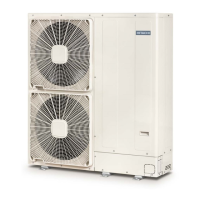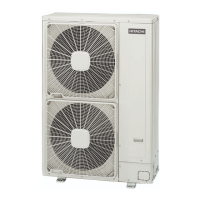What to do if Hitachi Air Conditioner has Receiver Communication failure?
- AalvarezjaimeAug 31, 2025
If your Hitachi Air Conditioner is not receiving a signal, check the Opentherm/Hlink connection.

What to do if Hitachi Air Conditioner has Receiver Communication failure?
If your Hitachi Air Conditioner is not receiving a signal, check the Opentherm/Hlink connection.
What to do if Hitachi YUTAKI M RASM-6VNE Air Conditioner shows abnormal transmission between outdoor and indoor units?
If your Hitachi Air Conditioner shows 'Abnormal transmission between outdoor and indoor units', check the wiring, terminals, and PCB for faults. This issue can be caused by incorrect wiring, loose terminals, PCB failure, a tripped fuse, or the power supply being OFF.
Why does my Hitachi YUTAKI M RASM-6VNE Air Conditioner activate safety device from excessively high discharge pressure?
If your Hitachi Air Conditioner activates the safety device due to excessively high discharge pressure, inspect the heat exchanger and refrigerant conditions. This activation can be caused by overload (obstruction of HEX, short circuit), a mixture of inert gas, or excessive refrigerant.
What causes Hitachi YUTAKI M RASM-6VNE Air Conditioner to activate safety device from excessively low suction pressure?
If your Hitachi Air Conditioner activates the safety device from excessively low suction pressure, inspect refrigerant levels and piping for blockages. This issue is often due to a shortage or leakage of refrigerant, piping clogging, a closed expansion valve, or a locked fan motor.
How to troubleshoot Hitachi YUTAKI M RASM-6VNE Air Conditioner hydraulic alarm flow and water pump malfunction?
If your Hitachi Air Conditioner displays a hydraulic alarm related to flow and water pump malfunction, check the water pump for proper operation and repair or replace it if defective. This alarm indicates that water flow is not detected in the hydraulic cycle or the pump is defective.
What to do if Hitachi YUTAKI M RASM-6VNE shows Thermostat Heater Alarm?
If your Hitachi Air Conditioner is showing a high temperature in the electric heater, check the electric heater for proper operation.
How to fix Hitachi YUTAKI M RASM-6VNE activation of overcurrent protection?
If your Hitachi Air Conditioner activates overcurrent protection, inspect the inverter PCB and compressor operation. This can be caused by overload, overcurrent, failure of the Inverter PCB, a clogged heat exchanger, a locked compressor, or EVI/EVO failure.
How do I fix a 'Unit Capacity setting Error' on my Hitachi Air Conditioner?
If your Hitachi Air Conditioner displays a 'Unit Capacity setting Error', ensure correct capacity settings for both indoor and outdoor units. This error indicates a mismatch between the indoor and outdoor unit capacities.
How to correct Hitachi YUTAKI M RASM-6VNE incorrect indoor unit number setting?
If your Hitachi Air Conditioner displays 'Incorrect indoor unit number setting', correct the indoor unit number settings. This issue can be caused by duplication of indoor unit numbers or the number of indoor units exceeding specifications.
How to fix Incorrect PCB Setting in Hitachi YUTAKI M RASM-6VNE?
If your Hitachi Air Conditioner shows 'Incorrect PCB Setting', correct the DSW settings. This issue is caused by a wrong DSW setting in the case of Co041.
| Brand | Hitachi |
|---|---|
| Model | YUTAKI M RASM-6VNE |
| Category | Air Conditioner |
| Language | English |
Provides detailed safety instructions, including dangers and cautions for installation and operation.
Emphasizes careful reading of manuals, product specifications, and safety warnings.
Presents nominal capacity and performance data for YUTAKI S in heating and cooling operations.
Details Energy-related Product (ERP) data for YUTAKI S space heaters.
Guides the user through the initial setup and configuration of the unit controller.
Lists alarm codes for indoor units, their origin, detailed abnormality, and main factors.
Details alarm codes for outdoor units, including type of abnormality and main causes.
Outlines routine checks for the outdoor unit's fan, heat exchanger, piping, cabinet, and electrical parts.
Details periodic checks for the indoor unit's cabinet, water piping, water flow, and pressure.











